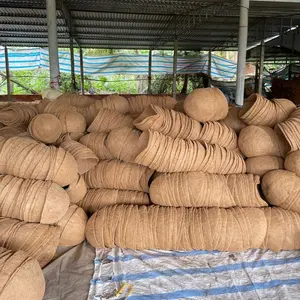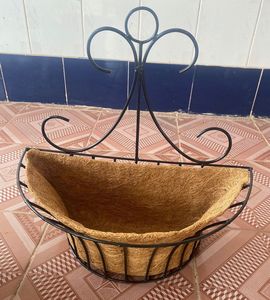(49 products available)











































































































































































































The natural, biodegradable, and sustainable coir fiber is used to make the coconut liner. The coconut husk is used to produce it. These are the types of replacement coco planter liners:
Natural Liners
The natural coconut fiber liner is woven from the fiber of the husk of the coconut. These liners are eco-friendly options for holding soil and plants. They break down naturally and support the growth of the plant. They offer good drainage and airflow to the roots. They are ideal for all planters and are a natural choice for any garden.
Pre-formed Liners
Pre-formed liners are manufactured to fit specific pots and planters. They come in various sizes and shapes that match the contours of the containers. These liners provide convenience, eliminate the need to cut or shape the liner to fit, and save time.
Roll Liners
Roll liners come in a large roll of coco fiber material. They allow for customization and are great for creating large planters or irregularly shaped containers. They offer flexibility and are also great for projects that require a large liner.
Lined Planters
Some planters come with coco liners already installed. These are called lined planters and eliminate the need to buy a separate liner. They offer convenience and save time during setup.
Double-Layer Liners
Double liners have two layers of coco fiber. They provide extra support for the plant and improve drainage. They are ideal for large planters that hold heavy plants.
Organic Liners
Organic coconut fiber liners are made from coconuts grown without chemical fertilizer. They are safer for the environment and for organic farming. They also provide better support for the roots. They are a good choice for all types of plants.
Customizable Liners
Some coconut liners are made to be easily customized. They can work with many different pot designs. These liners can be cut or shaped as needed to fit the container perfectly.
Natural Fiber Material
Coconut husk liners are made from natural fibers of coconut husks. These fibers are tough, flexible, and interwoven to create a breathable liner. The natural material allows for good airflow and drainage, which is healthy for plant roots. They come in a brown color, varying from light to dark, depending on how much of the outer husk is retained.
Manufacturing Process
The manufacturing process involves soaking coconut husks to separate the hard fibers from finer coir strands. The cleaned fibers are then pressed into molds in layers, shaped to fit specific pots or baskets. Finally, the liners are dried and shaped further before trimming excess material along the edges.
Shape and Size
Coconut liner replacements come in various shapes and sizes to fit different planters. They are shaped to fit hanging baskets, floor pots, and wall planters. Commonly, they will be round to fit inside a basket or pot top. The pre-cut liners simplify replanting without making a mess by providing a ready-to-use option that matches the container shape.
Breathability and Drainage
One of the best features of coconut coir liners is their breathability. The interwoven fibers create tiny air channels that allow oxygen to reach plant roots. This prevents root rot and keeps plants healthy. They also drain excess water well, so they suit both dry and wet-loving plants.
Durability and Longevity
While natural, coconut husk liners are durable. They withstand sunlight and weather changes well, unlike some natural products that quickly break down. With proper care, these liners can last an entire growing season or more before needing replacement. Their resilience makes them a cost-effective option for gardeners.
Eco-Friendliness
Coconut husk liners are an eco-friendly choice. They use a renewable resource from coconut farms. Choosing these natural liners over synthetic ones from artificial materials helps reduce environmental impact. They also decompose back to soil nutrients, supporting sustainable gardening. This makes them a great choice for gardeners wanting to protect the earth while growing plants.
Outdoor Planters
Outdoor planters are exposed to the elements, and over time, coco liners may wear out due to sun damage, heavy rain, or extreme temperatures. Seasonal planting, as described above, may require replacing the liner every spring or fall to accommodate different plants that have specific soil requirements.
Hanging Baskets
Like outdoor planters, hanging baskets also face exposure to the elements. They tend to be more susceptible to liner wear because of constant movement in the wind. If the basket is large enough, it may need a liner replacement every few months to ensure the plants stay healthy and have enough space to grow.
Wall-mounted Planters
Wall-mounted planters can be a decorative addition to any home or office, but after some time, the liners may lose their structural integrity and become less effective at retaining moisture and providing the necessary support for plants. This scenario may warrant a liner replacement to restore the planter's functionality and prolong its lifespan.
Terrace and Balcony Gardens
Terrace and balcony gardens are extensions of outdoor spaces, and coco liners in these areas may degrade faster due to constant exposure to sunlight and varying weather conditions. In addition, they usually require more frequent maintenance to ensure their structural integrity and effectiveness at retaining moisture is intact.
Residential and Commercial Green Roofs
Green roofs provide insulation, reduce stormwater runoff, and promote biodiversity. Coco liners in these areas can lose their properties due to root infiltration, erosion from wind or rain, and degradation from temperature fluctuations. This scenario may require a replacement to sustain the ecological benefits of green roofs and ensure plants thrive.
Size and Shape
Choosing the right coco liner for the planter's size and shape is necessary. If the liner is too small, it will not cover the planter's interior properly, leaving the soil exposed. This can lead to soil erosion and weed growth. A liner that is too large may be challenging to fit and could bunch up, creating an unappealing look.
Material Quality
Opt for liners made from high-quality coco coir. Good quality coco liners will have good water retention properties, are durable, and can resist tearing or fraying. They should be made from natural, eco-friendly materials without added chemicals that could harm plants.
Drainage
Check if the coco liners have pre-cut drain holes or if it's easy to make them. Proper drainage is necessary to prevent water from collecting at the bottom of the planter. Water build-up can damage the liner and plant roots, leading to root rot.
Thickness
Consider the thickness of the coco planter liners. A thicker liner will last longer and better protect the planter. However, if the liner is too thick, it might not fit well in the planter or around the plants. Find a balance by choosing a liner with suitable thickness.
Environmental Impact
Choose coco liners made from sustainably sourced coco coir. Look for products with eco-friendly certifications. These liners are better for the environment and reduce the negative impact of planting on nature. Consider the environmental footprint of the chosen planter liners.
Ease of Use
Choose a coco planter liner that is easy to use. It should be simple to place in the planter and work well with the plants. An easy-to-use liner saves time and effort when setting up the planter and caring for the plants. Consider how user-friendly the liner is before buying it.
Q1: What are the benefits of using replacement coco planter liners?
A1: Coconut fiber liners have good drainage, maintain moisture, and are eco-friendly. They also support healthy plant growth and are durable, making them a cost-effective option for gardening.
Q2: How often should one replace coco liners?
A2: Coco liners are usually replaced every season or annually, depending on usage. Regular checks will help determine when to replace them to ensure they are in good condition to support healthy plant growth.
Q3: Can one use coco liners with any type of planter?
A3: Coco liners can be used on all kinds of planters, but they work best in wireframe hanging baskets. They fit into most standard-sized planters and are versatile, providing excellent drainage and aeration for all types of plants.
Q4: What sizes do replacement coco planter liners come in?
A4: Coco planter liners are available in various sizes, from small to large, to fit different planters. They can also be gotten in custom sizes to fit specific planter requirements.
Q5: Are coco liners easy to maintain?
A5: Yes, coco liners are easy to maintain. They only need regular watering like any other gardening option. Avoid overwatering to prevent mold growth and plant root rot.